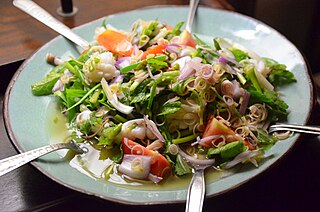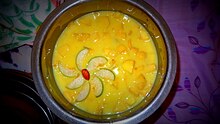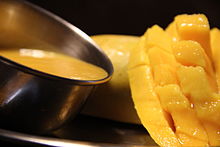
Malaysian cuisine consists of cooking traditions and practices found in Malaysia, and reflects the multi-ethnic makeup of its population. The vast majority of Malaysia's population can roughly be divided among three major ethnic groups: Malays, Chinese and Indians. The remainder consists of the indigenous peoples of Sabah and Sarawak in East Malaysia, the Orang Asli of Peninsular Malaysia, the Peranakan and Eurasian creole communities, as well as a significant number of foreign workers and expatriates.

Jaggery is a traditional non-centrifugal cane sugar consumed in the Indian subcontinent, Southeast Asia, Central America, Brazil and Africa. It is a concentrated product of cane juice and often date or palm sap without separation of the molasses and crystals, and can vary from golden brown to dark brown in colour. It contains up to 50% sucrose, up to 20% invert sugars, and up to 20% moisture, with the remainder made up of other insoluble matter, such as wood ash, proteins, and bagasse fibres. Jaggery is very similar to muscovado, an important sweetener in Portuguese, British and French cuisine. The Kenyan Sukari ngutu/nguru has no fibre; it is dark and is made from sugarcane and also sometimes extracted from palm tree.

Rice pudding is a dish made from rice mixed with water or milk and commonly other ingredients such as sweeteners, spices, flavourings and sometimes eggs.

Iraqi cuisine is a Middle Eastern cuisine that has its origins in the ancient Near East culture of the fertile crescent. Tablets found in ancient ruins in Iraq show recipes prepared in the temples during religious festivals—the first cookbooks in the world. Ancient Mesopotamia was home to a sophisticated and highly advanced civilization, in all fields of knowledge, including the culinary arts.
Maharashtrian or Marathicuisine is the cuisine of the Marathi people from the Indian state of Maharashtra. It has distinctive attributes, while sharing much with other Indian cuisines. Traditionally, Maharashtrians have considered their food to be more austere than others. The best quality food is available in the nashik district which include their world famous Misal.

Odia cuisine is the cuisine of the Indian state of Odisha. Compared to other regional Indian cuisines, Odia cuisine uses less oil and is less spicy, while nonetheless remaining flavourful. Rice is the staple food of this region. Mustard oil is used in some dishes as the cooking medium, but ghee is preferred in temples. Odia foods traditionally served either on brass, bronze metal plates, banana leaf or disposable plates made of sal leaves.

A rice cake may be any kind of food item made from rice that has been shaped, condensed, or otherwise combined into a single object. A wide variety of rice cakes exist in many different cultures in which rice is eaten. Common variations include cakes made with rice flour, those made from ground rice, and those made from whole grains of rice compressed together or combined with some other binding substance.

Peranakan cuisine or Nyonya cuisine comes from the Peranakans, descendants of early Chinese migrants who settled in Penang, Malacca, Singapore and Indonesia, inter-marrying with local Malays. In Baba Malay, a female Peranakan is known as a nonya, and a male Peranakan is known as a baba. The cuisine combines Chinese, Malay, Javanese, South Indian, and other influences.

Colombian cuisine is a culinary tradition of the six main regions within Colombia. Colombian cuisine varies regionally and is influenced by Indigenous Colombian, Spanish, and African cuisines, with a slight Arab influence in some regions.
Bhojpuri cuisine is a style of food preparation common among the Bhojpuri people of Bihar, Jharkhand and eastern Uttar Pradesh in India, and also the Terai region of Nepal. Bhojpuri foods are mostly mild and tend to be less hot in terms of spices used. The cuisine consists of both vegetable and meat dishes.

Pashtun cuisine refers to the cuisine of the Pashtun people and is covered under both Afghan and Pakistani cuisines. It is largely based on meat dishes including mutton, beef, chicken, and fish as well as rice and some other vegetables. Accompanying these staples are dairy products, various nuts, local vegetables, and fresh and dried fruits. Peshawar, Islamabad, Kabul, Bannu, Quetta, Kandhar and Mardan are centers of Pashtun cuisine.

A great variety of cassava-based dishes are consumed in the regions where cassava is cultivated, and the ingredient is included many national or ethnic specialities.

Mizrahi Jewish cuisine is an assortment of cooking traditions that developed among the Mizrahi Jewish communities of the Middle East, North Africa and Central Asia. Influenced by the diverse local culinary practices of countries such as Morocco, Libya, Egypt, Iraq, Iran, Yemen, and Syria, Mizrahi cuisine prominently features rice, legumes, meats, and an array of spices such as cumin, turmeric, and coriander. Signature dishes include kubbeh (dumplings), pilafs, grilled meats, and stews like hamin.
Pará cuisine refers to the traditional cuisine native to Pará, Brazil. Foods from this region primarily draw influence from Indian, African, and Portuguese cultures. The core ingredients are sourced from the Amazon jungle, and may include meats such as shrimp, crab, seafood, fish, poultry, bush meat, and duck; these are all cooked with leaves, peppers, and herbs. Dishes are cooked in clay pots or barbecued in moquéns and soaked in tucupi, a yellow sauce extracted from wild manioc root native to the Amazon. Dishes may be served in bowls, in containers of clay, wrapped in cocoons of banana leaves, or in urupemas.

Salads that are internationally known as Thai salads with a few exceptions fall into four main preparation methods. In Thai cuisine these are called yam, tam, lap and phla. A few other dishes can also be regarded as being a salad.

Maithil cuisine, also known as Mithila cuisine, is a part of Indian and Nepalese cuisine. It is the traditional cooking style of Maithils residing in the Mithila region of the subcontinent.















